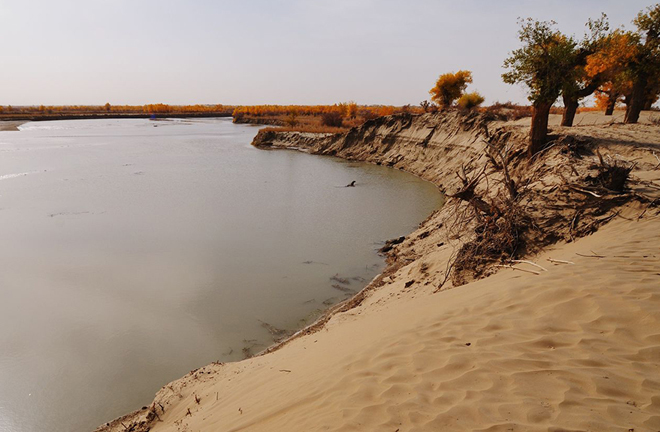Research on Keriya River basin finds signs of ancient cultural exchange

Lying on the southern border of the Taklimakan desert, the Keriya River historically bred rich oasis-based civilizations. Photo: FILE
The Keriya River basin is a holy land for scholars across the world who study geology, biology, palaeoclimatology and other environmental sciences with a focus on the desert. It is also a key area for solving the riddle of the cause and formation of the Taklimakan Desert, mastering the rules regarding desert climate and understanding the interactive relationship between human activities and desert environments.
Recently, a group researching “Climate and Environmental Change in the Hetian Oasis—Investigation on the Natural and Living Environment in the Whole Desert Basin of the Keriya River” conducted a comprehensive investigation into the dry ancient middle and lower reaches of the Keriya River in the Hetian Area of the Xinjiang Uygur Autonomous Region.
The Keriya River is at the southern edge of the Taklimakan Desert. Historically, the Keriya River bred rich oasis-based civilizations and left deep marks on the southern route of the ancient Silk Road. Li Chengsen, former curator of Beijing Natural History Museum, said that Daliyabuyi Oasis is currently the largest oasis in the Keriya River basin. The Keriya people living there have played a significant role in the history of the development of western China.
Over the last several decades, following desertification, the length of the dry river bed at the lower reach of the Keriya River has increased, and the period involved for the flood to irrigate the lands has substantially shortened. The natural vegetation gradually decayed and the natural oasis shrank. The secondary salinization of the soil became aggravated and the ecological system of the desert became more vulnerable.
Li Xiao, a professor from the School of Chinese Classics at Renmin University of China, said that a scientific investigation group was established to conduct a comprehensive investigation of the historical environment of the Keriya River basin so as to help preserve the natural oases at the basin, protect the natural and ecological environment in the Hetian Area and achieve the harmonious development of humanity and nature. This investigation aims to provide historical experiences and theoretical support to regional protection of the ecological environment and to construction of an ecological civilization, Li said. It is the first time that a multi-disciplinary and comprehensive investigation has been conducted in the depopulated desert zone, Li added.
On the basis of a comprehensive investigation of the Taklimakan Desert basin, scholars from the investigative group gained a more comprehensive understanding of the types of local ancient culture. Zhang Huajie, director of the Department of Cultural Relics Hetian Area, said the Humanistic Science Division of the investigation group, during the investigation along the old channels of the Keriya River, found and demarcated 47 cultural relics, including 17 sites of ancient cities, residences and channels, 5 tombs, and 25 scattered sites of cultural relics. They collected about 70 bags of items that were made from pottery, stone, jade, bronze, iron, colored glaze and fabric.
Li Xiao suggested that the culture in the Keriya River basin in a timespan of around 4,000 to 2,000 years consisted roughly of three ancient cultural factors—the aboriginal culture represented by northern tombs, the culture from the Altay area that entered the desert by passing over the Tianshan Mountains, and the ancient culture from Central Asia that entered the desert by coming over the Pamirs Plateau. He said that by as late as the early Bronze Age, a complete set of jade mining, processing, utilizing and trading mechanisms had already appeared in the ancient Keriya River basin. Later, Hetian jade gradually spread to eastern areas, and by the Shang Dynasty, Hetian jade was considered the best by Central China jade culture.
Zhang said that judging from the items originally produced in ancient Central China, including round flat pieces of stone with holes in the centre, the Keriya River basin had already been participating in cultural exchanges with Central China for at least 4,000 years.
(edited by CHEN ALONG)
